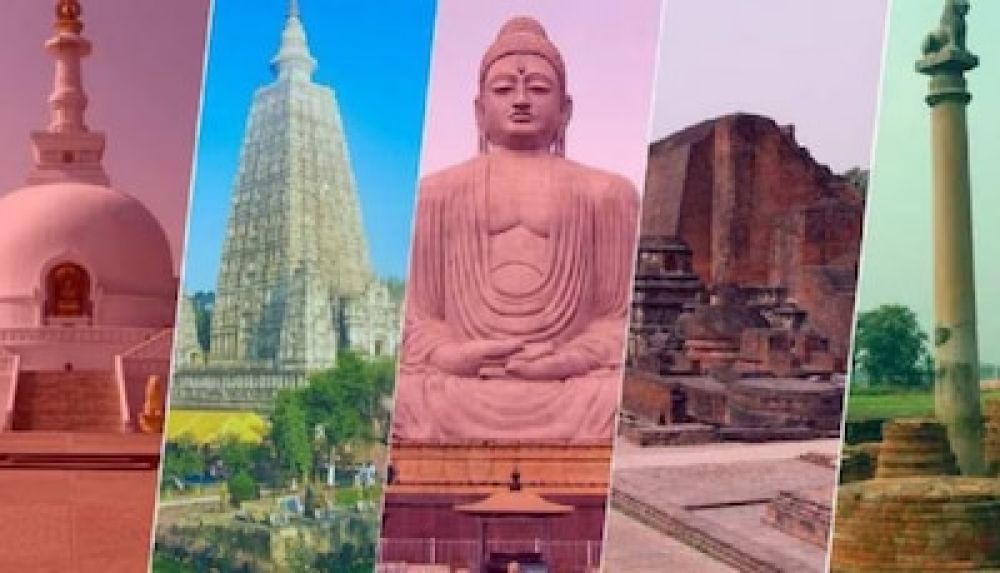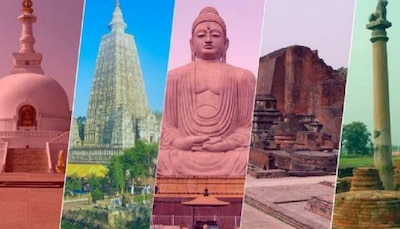

The Mahabodhi Temple, located in Bodh Gaya, is one of the most significant and revered sites in Buddhism. It stands on the very ground where Lord Buddha attained enlightenment under the Bodhi Tree. The temple complex has been declared a UNESCO World Heritage Site, making it a must-visit for any spiritual seeker or history enthusiast. The architecture is a stunning representation of ancient Indian craftsmanship, and the atmosphere is filled with a sense of peace and divinity. Devotees and tourists can explore the temple's intricacies, meditate, or marvel at the Great Buddha Statue nearby. The Mahabodhi Temple is not just a monument; it's a living testament to a pivotal moment in religious history and a beacon of Buddhist philosophy.
Nalanda University was an ancient center of learning and one of the world's first residential universities, which thrived between the 5th and 12th centuries. Today, the ruins of this historic institution lie in Bihar and offer a glimpse into a past where scholars from all over the world came to study. The extensive red-brick complex is an archaeological wonder that includes stupas, shrines, viharas (monastic quarters), and intricate artworks. As you walk through the site, you can almost hear the echoes of ancient debates and discussions on philosophy, astronomy, theology, and medicine. A visit here is both educational and inspiring, leaving one in awe of the intellectual prowess that once flourished in this region.
As Bihar's only national park, Valmiki National Park offers a diverse range of flora and fauna including the royal Bengal tiger, Indian rhino, and various species of deer. The park is a part of the Valmiki Tiger Reserve and provides thrilling jeep safaris for wildlife enthusiasts. During a safari, you can witness the rich biodiversity of the region in its forest-covered hills and meandering rivers. The guides are knowledgeable, enhancing your experience with interesting facts about the animals and their habitats. Valmiki National Park is a great place to connect with nature and experience the thrill of spotting wild animals in their natural surroundings.
Gandhi Ghat, situated along the banks of the Ganges in Patna, is one of the most peaceful spots to visit in the city. Here, you can enjoy a serene boat ride on the sacred river Ganga, which is not only a calming experience but also offers a panoramic view of the city's skyline from the water. The evenings are particularly mesmerizing as the 'Ganga Aarti' takes place daily, and witnessing it from the boat provides a unique perspective. The aarti ceremony is a spiritual spectacle with priests performing rituals with synchronized movements, lamps, and chants, creating an enchanting atmosphere that engulfs every visitor in a feeling of reverence and tranquility.
Rajgir is an ancient city surrounded by hills and is recognized for its historical and spiritual importance. Trekking in Rajgir is a refreshing adventure that takes you through lush greenery, rocky trails, and historical sites such as Vishwa Shanti Stupa (Peace Pagoda) and various ruins connected with Lord Buddha’s life. As you ascend the hills, the air gets cooler, and from the top, one can enjoy majestic views of the entire valley and city below. It's not only a physical activity but also an enlightening journey as you get to learn about the ancient history and spiritual heritage of the region. The guided treks ensure you don't miss out on any of the lore or landmarks that make Rajgir a fascinating place to discover.
The Sonepur Mela, held annually during the Hindu month of Kartika (November-December), is one of the largest cattle fairs in Asia and a spectacle that combines spirituality with commerce. The fair is held at the confluence of the Gandak and Ganges rivers and has a tradition dating back to the Mauryan empire. This vibrant event attracts visitors from all over India and abroad. Pilgrims come to take a holy dip at the confluence, while traders engage in the buying and selling of various livestock. Beyond the commerce, there are numerous cultural events, traditional dances, folk music, and theater performances to experience. The fair also features a range of handicrafts, regional cuisine, and amusement activities for all ages.
A street food tour in Patna is a gastronomic journey through the city's bustling streets and markets. The capital of Bihar is renowned for its delicious regional delicacies such as Litti Chokha (a traditional Bihari dish made of sattu and served with eggplant and tomato chutney), Sattu Paratha, and an array of sweets like Khaja and Anarsa. Exploring the food scene is not only about savoring these dishes, but it also offers a chance to glimpse into the daily life of the locals and their culinary traditions. You can enjoy freshly prepared snacks from street vendors, sipping on chai, and indulging in conversations with the friendly residents. It’s an authentic experience of the tastes and textures that make Bihari cuisine unique.
Kanwar Lake Bird Sanctuary, located in the Begusarai district of Bihar, is an ornithologist's paradise and one of the largest freshwater oxbow lakes in Asia. This sanctuary is home to over 60 species of migratory birds that visit during the winter months, turning the area into a vibrant spectacle of avian life. Birdwatchers can enjoy the sight of numerous bird species in their natural habitat, including the grey heron, white ibis, and various types of ducks. The tranquility of the lake and the lush green surroundings provide an ideal setting for photography and peaceful contemplation. A visit to Kanwar Lake is not only a treat for bird enthusiasts but also for anyone who appreciates the serenity and beauty of nature.
Madhubani, also known as Mithila, is the origin place of the world-famous Madhubani painting, a traditional Indian folk art known for its vibrant colors and intricate patterns. Participating in a Madhubani painting workshop is a deep dive into the cultural heritage of Bihar. Local artisans host these workshops, offering visitors a chance to learn the techniques behind these unique paintings first-hand. The workshops are a delightful blend of learning, creativity, and cultural exchange. Not only do participants walk away with their own handmade artwork, but they also help in sustaining a valuable art form and supporting the local artist community.
Vikramshila was one of the two most important centers of Buddhist learning in India during the Pala dynasty alongside Nalanda University. Situated in the Bhagalpur district of Bihar, the Vikramshila ruins hold historical and educational significance. Founded by King Dharmapala in the late 8th or early 9th century, Vikramshila University was a major seat of Tantric Buddhism and attracted scholars from near and far. Though less prominent than the ruins of Nalanda, Vikramshila nonetheless offers an enriching experience for those interested in history and architecture. The site includes a central stupa, a monastery with individual cells for monks, and several other structures. A visit is a compelling look back into the scholarly achievements of ancient India.
